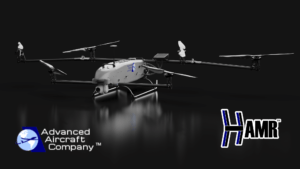
Continue reading below, or listen:
HAMR’s multi-rotor configuration and distributed electric propulsion system give the aircraft outstanding flight endurance. In addition, HAMR can accommodate multiple, simultaneous payloads. “The aircraft can be optimized for a wide range of defense applications and mission profiles, including tactical ISR, perimeter security, search and rescue, and medical supply delivery missions,” says the company announcement.
“We are thrilled to have been awarded an SBIR Phase II contract and look forward to continuing development of our UAS to aid our warfighters on the battlefield,” said Paul Allen, CEO of AAC. “Our HAMR UAV’s high-performance, efficient propulsion system, rugged aerodynamic airframe, ease of use, and serviceability in the field make it ideally suited for demanding military operations in the most austere environments.”
HAMR’s distributed electric propulsion system incorporates an electronic fuel-injected and computer-controlled dual piston engine driving an integrated electric generator producing up to 4000W to power the onboard sensors, six independent brushless DC electric motors, and a backup battery.
HAMR has a maximum payload capacity of 12 pounds and dual payload bays. This means the UAS can carry multiple sensors or devices, including a wide range of optimal or infrared cameras, LiDAR systems, EO, IR, or communications systems; or can carry additional fuel for longer flight endurance.
Designed for military use, HAMR is extremely portable and can be launched quickly without ground support infrastructure. It can also be disassembled and easily transported in a single case. Importantly, HAMR is engineered to optimize operational uptime. Using line replaceable units (LRUs) the aircraft can be serviced in the field by personnel with minimal training.
Read more:
- AFWERX: How the Air Force and DoD are Supporting Innovation in the Drone Industry; and Vice Versa
- Mayman Aerospace Wins AFWERX Grant for Speeder Air Utility Vehicle, Ultra Compact VTOL
- Hybrid Electric UAV from Advanced Aircraft Systems: HAMR UAVs Selected by AFWERX
- Advanced Aircraft Company Brings on New Leadership
Miriam McNabb is the Editor-in-Chief of DRONELIFE and CEO of JobForDrones, a professional drone services marketplace, and a fascinated observer of the emerging drone industry and the regulatory environment for drones. Miriam has penned over 3,000 articles focused on the commercial drone space and is an international speaker and recognized figure in the industry. Miriam has a degree from the University of Chicago and over 20 years of experience in high tech sales and marketing for new technologies.
For drone industry consulting or writing, Email Miriam.
TWITTER:@spaldingbarker
Subscribe to DroneLife here.